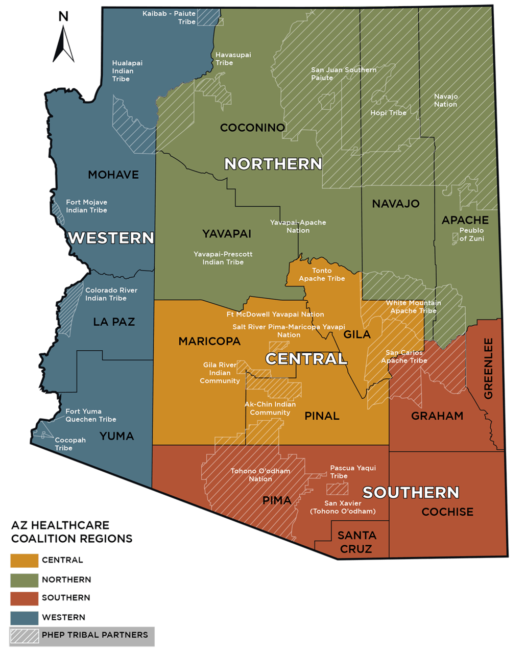Before 2019, Arizona maintained six distinct and independent healthcare coalitions. Four of them were regionally based and two were population-based, targeting pediatric and tribal communities. In July of that year, the six coalitions merged to form one statewide healthcare coalition called the Arizona Coalition for Healthcare Emergency Response, or AzCHER.
With a consolidated coalition, AzCHER members gained access to a broader information and resource exchange network and a more robust staff infrastructure that is better able to meet members’ needs. Other benefits of the unification include streamlined administration, greater access to trainings and exercises, opportunities to contribute to statewide planning, and more consistent communications.
AzCHER remains committed to incorporating and addressing regional factors, such as geographical, cultural, demographic, and healthcare industry characteristics. As such, the staff team includes four regional managers who are dedicated to ensuring that local interests are taken into consideration, and each region has its own steering committee of lead volunteers who guide coalition operations. Regional input is then aggregated at the statewide level through combined plans, trainings, exercises, and response functions.
Central Region
Jamie Beauvais, Regional Manager
Counties: Gila, Maricopa, Pinal
Tribes: Tonto Apache Tribe, Fort McDowell Yavapai Nation, Gila River Indian Community, Salt River Pima-Maricopa Indian Community, Tohono O’odham Nation, Ak-Chin Indian Community, San Carlos Apache Tribe
Major Cities: Payson, Globe, Phoenix, Mesa, Chandler, Glendale, Scottsdale, San Tan Valley, Casa Grande, Maricopa
Landmarks: Tonto National Monument, Sonoran Desert National Monument, Superstition Mountains, Hohokam Pima National Monument
Licensed Beds: 9,635
Licensed Hospitals: 52
Skilled Nursing Facilities: 89
Healthcare Facts: The Central Region is home to a total of 52 hospitals, including 7 Acute Care facilities and 1 VA Medical Center.
Southern Region
Amy Di Miceli, Regional Manager
Counties: Cochise, Graham, Greenlee, Pima, Santa Cruz
Tribes: San Carlos Apache Tribe, Pascua Yaqui Tribe, Tohono O’odham Nation
Major Cities: Sierra Vista, Safford, Clifton, Tucson, Nogales
Landmarks: 5 National Monuments/Historic Sites, 6 Conservation Areas/National Forests, Mt. Lemmon
Licensed Beds: 3,182
Licensed Hospitals: 30
Skilled Nursing Facilities: 30
Healthcare Fact: There is one healthcare provider for every 382 residents in the Southern Region.
Northern Region
Western Region
Shawna Murphy, Regional Manager
Counties: Apache, Coconino, Navajo, Yavapai
Tribes: Navajo Nation, Havasupai Tribe, Kaibab Band of Paiute Indians, White Mountain Apache Tribe, Hopi Tribe, Yavapai-Apache Nation, Yavapai-Prescott Indian Tribe, Pueblo of Zuni, San Juan Southern Paiute Tribe
Major Cities: Flagstaff, Show Low, Winslow, Prescott, Sedona
Landmarks: 5 National Forests, 8 National Monuments/Recreation Areas, Grand Canyon National Park
Licensed Beds: 1,105
Licensed Hospitals: 15
Skilled Nursing Facilities: 17
Healthcare Facts: The Northern Region has one Level 1 Trauma Center. Six of the Acute Care facilities are located on Tribal Lands.
Counties: La Paz, Mohave, Yuma
Tribes: Colorado River Indian Tribes, Fort Mojave Indian Tribe, Kaibab Band of Paiute Indians, Hualapai Tribe, Fort Yuma Quechan Tribe, Cocopah Indian Tribe
Major Cities: Quartzsite, Parker, Bullhead City, Kingman, Lake Havasu City, Colorado City, Yuma, San Luis, Somerton, Wellton, Cabeza Prieta, Imperial
Landmarks: Rawhide Mountains Wilderness, Colorado River, Lake Mead National Recreation Area, Grand Canyon, Parashant National Monument, Pipe Spring National Monument, Kofa National Wildlife Refuges, Mojave Desert
Licensed Beds: 1,187
Licensed Hospitals: 10
Skilled Nursing Facilities: 12
Healthcare Fact: The Western Region includes two frontier designated facilities, nine rural primary care facilities, and seven tribal nations within the three counties.



